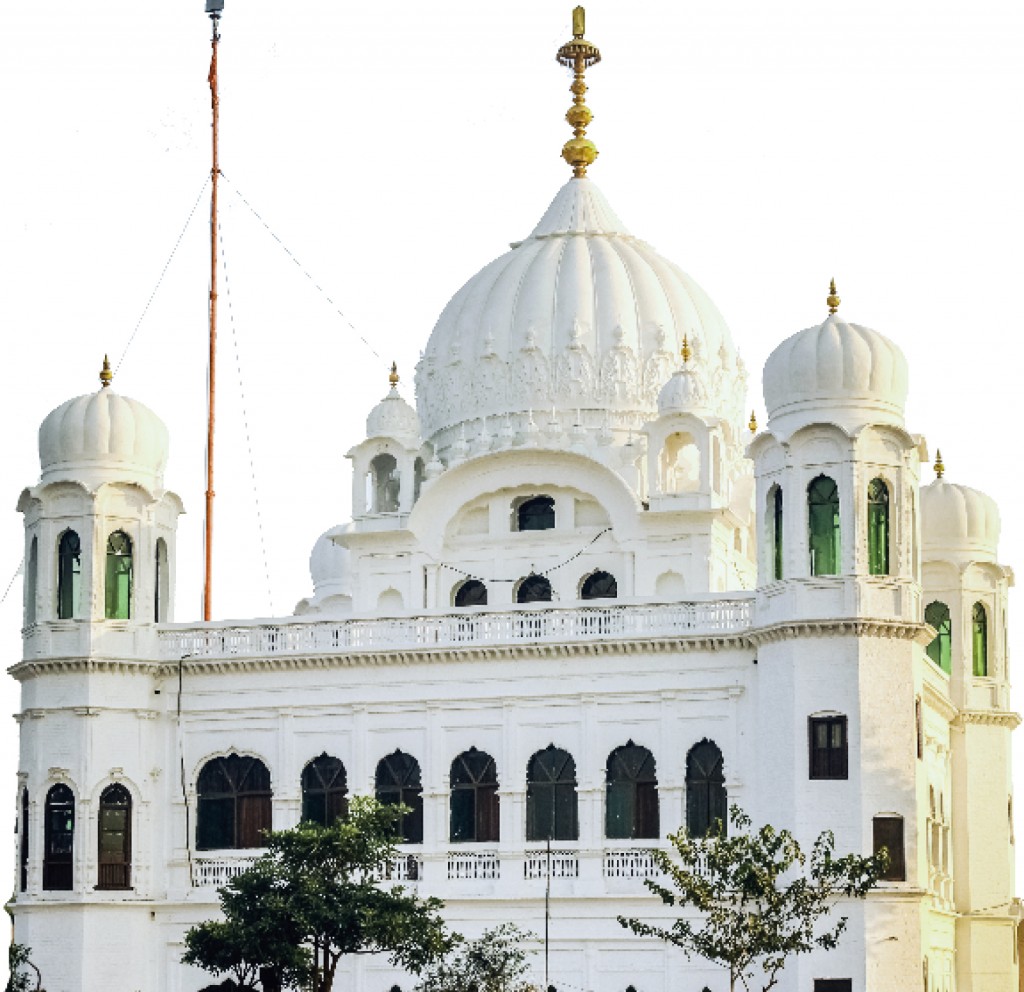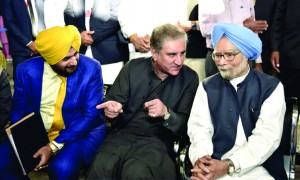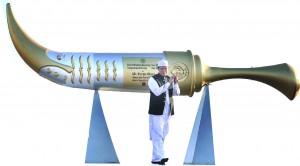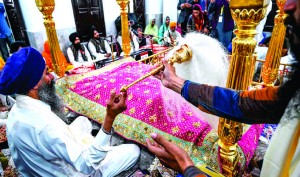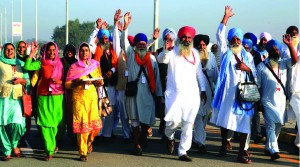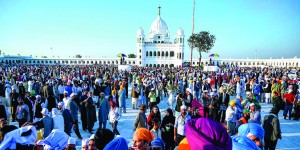Kartarpur Corridor
“The certain pathway to all things that you want is through the corridor of joy,” Esther Hicks.
On November 09, when confrontation and mistrust is the order of the day in the Subcontinent, Pakistan took a major step towards peace. On this very important day in the history of this region, Prime Minister Imran Khan inaugurated the Kartarpur Corridor in Narowal district of Punjab, allowing Indian Sikhs for the first time in 72 years to visit Gurdwara Darbar Sahib, one of Sikhism’s holiest shrines, in Pakistan through a visa-free corridor. In his speech at the event, Mr Khan called for peace and cross-border trade between Pakistan and India, while also highlighting the grim situation in India-held Kashmir, thus giving him a sterling reminder of what is possible when the human spirit soars over manmade borders and barriers in an all-conquering flight of imagination.
The opening of the Kartarpur Corridor represented a truly unique moment for a region which has suffered great tragedies and unbridled hostilities at the hands of national and religious prejudices. The manner in which the opening ceremony was conducted and the warmth with which Sikh pilgrims from across the border were welcomed into Pakistan represented the very ideals we as a nation should profess and aspire to achieve – religious, ethnic and international inclusivity. Prime Minister Imran Khan has rightly pointed out that the opening of Kartarpur Corridor was in line with the Islamic principles, Pakistan’s policy of promoting inter-faith harmony and the vision of Quaid-e-Azam of a peaceful neighbourhood.
Pakistan-India Peace?
Many hope that the goodwill generated by the Corridor and the prospects of increased people-to-people contacts could lead to better diplomatic relations between the two countries. Pakistani Prime Minister, Imran Khan, has even suggested that the corridor could mark the first step towards greater economic ties between the two countries. Given the tensions with India, the opening of the corridor gives Pakistan a diplomatic edge over India and establishes Pakistan’s wishes to establish peace in the region.
Religious Tourism
While the peace constituency on both sides has termed this a bold move by Pakistan and the Indian Prime Minister has acknowledged the expediency with which Pakistan completed the infrastructure-related arrangements, many do not see this as an intervention which could significantly bring down the ongoing political tensions between the two countries. What is however more certain, is that there will be economic benefits of Kartarpur for Pakistan. The governor of Pakistan’s eastern Punjab province has even claimed that religious tourism which has great potential to promote people-to-people contacts in the subcontinent. Kartarpur corridor could bring in $5 billion into the country every year as 5,000 visitors will be able to cross over from India daily to visit the shrine in Pakistan without a visa.
Babri Mosque vs Kartarpur
It was a coincidence of historical proportions when Supreme Court of India (SCI) chose to announce the verdict (reserved a month back) on 9th November, same day the Kartarpur Corridor was inaugurated by PM Imran Kahn in full media glare. Land expansion of Kartarpur from 5 acres of original land to hundreds of acres and spending millions of dollars is a testimony to Jinnah’s Pakistan while Babri Mosque verdict is a sad story of gradual and perpetual ostracizing of Muslims in India.
The dispute over land ownership has been one of India’s most heated issues, with Hindu nationalists demanding a temple on the site in the town of Ayodhya in Uttar Pradesh state for more than a century. The 16th century Babri Masjid mosque was destroyed by Hindu hard-liners in December 1992, sparking massive Hindu-Muslim violence that left some 2000 people dead. Top leaders of RSS were entrenched in New Delhi weeks before the verdict to ensure that the Supreme Court ruled in favour of Hindutva. In a travesty of justice, the Indian Supreme Court delivered a verdict in favour of the Hindus, which proves that Hindutva rules supreme, while justice can flee to brutish beasts.
Kashmir Issue
The promotion of religious tourism and people-to-people contacts should be pursued to reduce hostilities between Islamabad and New Delhi. However, the key irritants in the relationship — particularly the Kashmir issue — must not be lost sight of. Mr Khan rightly said at the Kartarpur event that a just solution to the Kashmir question could help bring peace to the subcontinent.
If India is serious about the pursuit of peace, a good first step would be to lift the siege of occupied Kashmir and let the beleaguered region’s people breathe. Constructive dialogue on Kashmir, together with confidence-building measures, can help break the deadlock in the subcontinent.
Conclusion
The Kartarpur corridor is intended as a gesture of friendship and acceptance of these links. It comes at a time when there is harsh hostility in New Delhi towards Pakistan. Perhaps the corridor can help bring about a change in New Delhi’s attitude. We also hope that in time India will consider opening up similar initiatives to allow Pakistanis to visit shrines and other places of religious significance to Muslims in India. After all, the line drawn by British colonial rulers in 1947 should not be allowed to keep people apart indefinitely. There are many holy places and other locations of significance to those living across the border in either country. We need to create policies which allow citizens to visit these and also expand the people to people contacts so essential to any peace process. The Kartarpur corridor is an important step in this.
Pakistan has extended a hand of friendship by facilitating Indian Sikhs in their demand to easily access Kartarpur; India must do the same and make arrangements for Pakistanis to visit Muslim sites in their country without hassle. This is a victory for the Pakistani side and it is important to build on this development. Pakistan in the last few years has been continuously pushing for better relations despite India’s aggressive and anti-Pakistan stance. It is important for the neighbouring countries to develop stable ties that can help the region grow economically and restore years old ties.
What is Sikhism?
Sikhism is a monotheistic religion born in the 15th-century in Punjab, a region spanning parts of what is now India and Pakistan. Five and a half centuries later, Sikhs number up to 30 million worldwide, with a rich diaspora in places such as Canada, the US and Europe — although the vast majority remain in India. Once rulers of the Punjab, they were considered a martial race by the British colonizers. Men, in particular, are instantly recognizable by their colorful turbans, used to cover their hair, which they must leave uncut. That is one of the five articles of their faith they must carry all the time, known as the Five Ks: the Kesh (uncut hair), Kara (a steel bracelet), Kanga (a wooden comb), Kaccha (cotton underwear), and Kirpan (a curved dagger). Sikhs worship God, known to them as Waheguru, or “wonderful teacher”, inside gurdwaras, or “doorways to God”. The word “Sikh” means the “seeker”, or the “learner”. Male Sikhs bear the name “Singh”, which means lion; while women go by “Kaur”, or princess.
Who was Guru Nanak?
Guru Nanak Dev was born in 1469 at Nanakana Sahib (57 miles from Lahore), to Hindu Khatris, Mehta Kalyan Das and Mata Tripta. While Guru Nanak’s father, Mehta Kalyan Das, was a crop revenue accountant of a local baron in the village of Talwandi (near Kasur district), his mother was Mata Tripta, a simple and religious woman. Guru Nanak had an elder sister, Nanki Ji, who was five years older to him. The Official Website of the “Shiromani Gurdwara Parbandhak Committee” in Amritsar states: “Guru Nanak was married to Mata Sulakhni ji, who gave birth to two sons, Sri Chand and Lakhmi Das. In November 1504, Guru Nanak’s elder sister Nanaki ji took him to Sultanpurlodhi where her husband Jai Ramji got him the job of storekeeper at Nawab Daulat Khan Lodhi’s darbar (court).” The Sikh website adds: “In the year 1520, Babar attacked India. His troops slaughtered thousands of innocent civilians of all walks of life. Women and children were held captives and all their property was looted. Guru Nanak Sahib challenged this act of barbarity in strong words. He was arrested and released, shortly after making Babar realize his blunder. All the prisoners were also released.” It further states: “Guru Nanak Sahib settled down at Kartarpur city (now in Pakistan) which was founded by him in 1522 and spent the rest of his life there.”
Guru Nanak was a born poet. He wrote 974 hymns. The collection of his holy hymns were compiled and sent to distant Sikh communities for use in morning and evening prayers. These later formed part of the Sikh holy book “Guru Granth Sahib,” which was written in Gurmukhi (literal meaning: From the Guru’s mouth) script. This script was modified, standardized and used by the second Sikh Guru, Guru Angad Dev, in the 16th century. The Gurmukhi script is still used by Sikhs and Indian Punjabi Hindus to write Punjabi language.
The “Guru Granth Sahib” was composed by the following Sikh Gurus: Guru Nanak Dev, Guru Angad Dev, Guru Amar Das, Guru Ram Das, Guru Arjan Dev, Guru Tegh Bahadur and Guru Gobind Singh.
The Sikh holy book’s text consists of 1,430 pages and 6,000 line compositions.
Where is Gurdawar Kartarpur Sahib?
Ensconced nicely like a white nugget in the russet glory of ripening wheat fields between River Ravi and Bein is Kartarpur where the founder of Sikh faith spent 18 years before leaving for his eternal abode. Kartarpur village was founded by Guru Nanak where he lived a happy eighteen years of his life, far from the madding crowd to the accompaniment of sounds and rhythms of his version of Punjabi utopia. Kartarpur had lain dormant and forgotten as a dusty hamlet after partition when the proximity to a border which had seen two major wars and several near wars rendered it unapproachable.
The gurdwara at Kartarpur is so close to the India-Pakistan frontier that its white dome and four cupolas can be seen from across the border. But the perennial enmity between the South Asian nations, arch-enemies since Pakistan was carved out of colonial India at independence from Britain in 1947, has meant that for decades Indians could not visit — at least, not easily. Many had likened it to Muslims being able to see Mecca or Medina, but never actually able to visit. For decades, the devotees of Sikh faith had wistfully glimpsed the pearly white lustre of the graceful Gurdawara from atop a mound a few miles across the border. The dream to open the second most holy Sikh shrine was ironically realized through the efforts of Pakistan’s new civil and military leadership that took the bold leap of faith in inviting Indian Government to cooperate in the project.
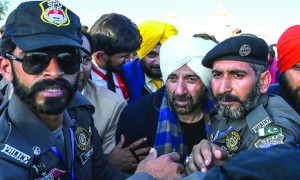 The offer from Pakistan came as a veritable shock to a xenophobic weltanschauung in India spawned by a self -same culture of religiously inspired hatred that the Sikh faith had come to root out in fifteenth century. While Pakistan had of late developed an unprecedented eagerness for opening the Kartarpur corridor, the BJP government was initially less than enthusiastic about it. However, it soon owned the project due to domestic compulsions while posing that the idea had originally come from its side.
The offer from Pakistan came as a veritable shock to a xenophobic weltanschauung in India spawned by a self -same culture of religiously inspired hatred that the Sikh faith had come to root out in fifteenth century. While Pakistan had of late developed an unprecedented eagerness for opening the Kartarpur corridor, the BJP government was initially less than enthusiastic about it. However, it soon owned the project due to domestic compulsions while posing that the idea had originally come from its side.
 Jahangir's World Times First Comprehensive Magazine for students/teachers of competitive exams and general readers as well.
Jahangir's World Times First Comprehensive Magazine for students/teachers of competitive exams and general readers as well.
